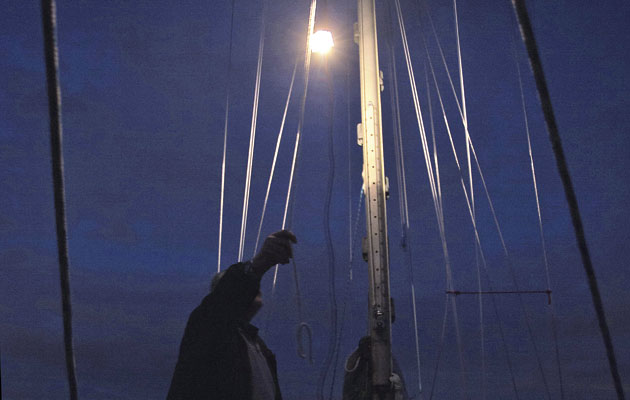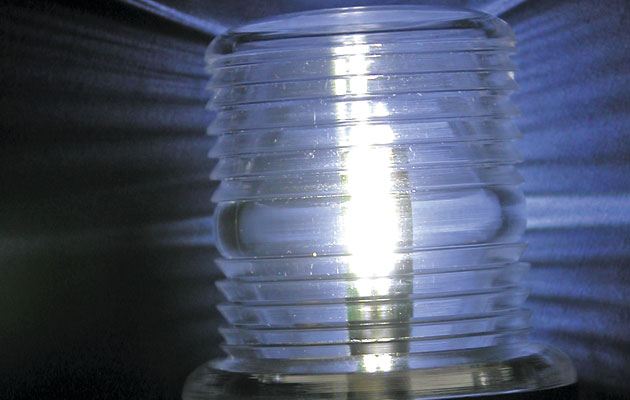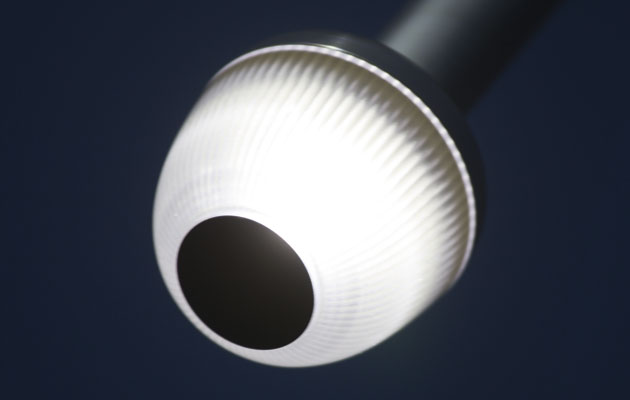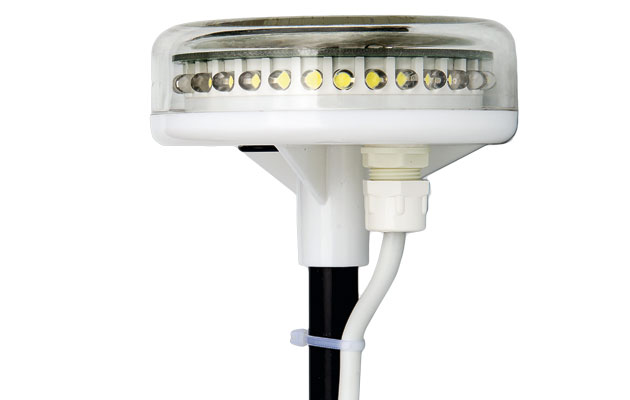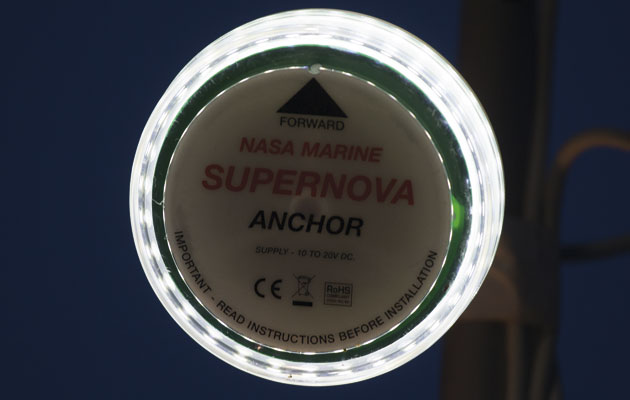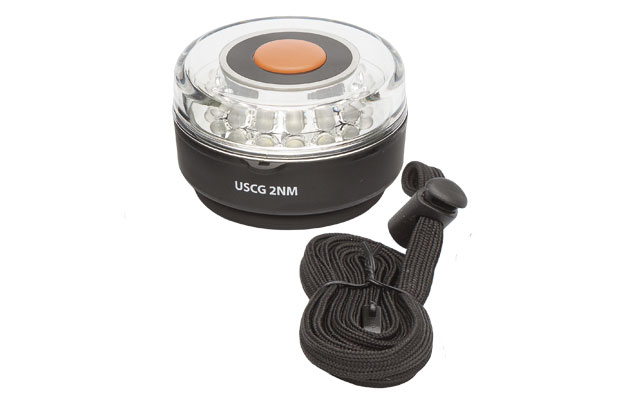Still relying on an old hurricane lamp at anchor? Duncan Kent tests the latest electric anchor lights
Anchor lights have changed rapidly over the past few years, partly due to the shift from incandescent filament bulbs to LEDs.
In addition to navigation lights, another area important to all cruising sailors is visibility when anchored.
Some skippers just hoist an old oil-powered hurricane lamp up a halyard, others deploy converted solar garden lamps, but if you really want to avoid being hit in the early hours by a latecomer to the anchorage it’s surely best to ensure your anchor light is clearly visible from a good distance.
Light Emitting Diodes (LEDs)
Nowadays, the problem of high current drain from your boat’s lights should be in the past.
Modern LED ‘bulbs’ are rapidly overtaking the old, inefficient filament-type bulbs, proving to be equally bright – brighter in many cases – and with a fraction of their power demands.
Being nearly 10 times as power-efficient as standard filament bulbs, as well as considerably more resistant to vibration and impact, they appear to be the ideal solution for all sailing boat lights.
They can be left on without the worry of flattening the ship’s batteries, but also the wiring required to power them can be reduced in size, minimising weight aloft where masthead and steaming lights are situated.
Wiring them up
LEDs are wired in a similar way to filament units. Although they are polarity sensitive, most can be wired up either way and they will still work, thanks to integral diode correction circuitry.
At worst, they simply won’t light if you reverse positive and negative, until you swap the wires over.
It is worth mentioning at this point that if you intend to keep the same wiring and just change the lamp or bulb to a lower power LED type, the circuit protection fuse or breaker must remain the same value as it is there to protect the wiring, not the device.
Reliability and lifespan
Almost as important as low power consumption is reliability.
When a masthead bulb blows, someone has to change it – something few sailors are inclined to do at sea.
Being less vulnerable to the typical jarring the masthead is likely to experience in rough sea states, LEDs are far less likely to blow during a bumpy passage.
In fact, most of the top quality units are quoted as having a 50,000-hour lifespan! F
or this reason it’s not surprising they are currently quite a bit more expensive than the incandescent bulb types, but this is likely to change once LED navlights become the norm.
Changing bulbs to LEDs
Many boat owners have converted their incandescent navigation lights to LED by simply swapping existing filament-type bulbs with the equivalent LED clusters.
Early LEDs were not very powerful and therefore not necessarily visible over the legally required range.
Nowadays, however, with the integration of miniature voltage regulators, most decent-quality LED clusters can accept any voltage between 10v and 30v DC, whilst retaining full brightness, regardless of the battery condition or voltage fluctuation.
Top quality LED clusters are encapsulated in resin to prevent water ingress.
Though more expensive, it makes sense to fit this sort, particularly to a masthead-mounted unit, to avoid the climb to replace it.
Despite the longevity of LEDs, bulb replacement clusters suffer the same problems with dirty or corroded contacts as filament bulbs, so it’s a good idea to grease up their contacts with silicone grease before installing them.
How we tested the anchor lights
In this test we took a selection of typical modern anchor lights – a mix of masthead mounting and hoistable types – and tested their visibility from a mile away to see if the new LED types were genuinely as easy to see from a distance as the traditional filament bulb models.
Taking all the anchor lights out on the editor’s boat late one June evening, we picked up a buoy in Calshot Bay and hung the lights in the foretriangle of the yacht, around 2.5m above deck level.
At first we tried lighting five of them at once, to see if we could compare them together, but 150m away the light started to merge into one bright blob, so we reverted to testing each one individually.
I set off across Southampton Water in our RIB, having set the boat as a mark on my GPS, so that I knew when I was exactly one nautical mile from the yacht.
Then, communicating via VHF radio, we lit each light and judged by eye as to how bright, white and clear to see they were – scoring them out of 10.
We did consider using a spot-beam analyser, but in the end the human eye is by far the most accurate detector of distant lights and, after all, that’s exactly what would happen in real life.
Later, back on land, we powered them up again to check their actual current consumption using an ammeter.
Where should an anchor light be fitted?
Every time I go off for a week, or even a long weekend, I spend as much time as possible at anchor.
There’s something about being in charge of your own destiny that culminates in a night at anchor.
After a good day’s sail I often end up entering an anchorage after dark, picking my way through a forest of unlit masts and almost imperceptible hull silhouettes.
Most boats are poorly lit – if at all – and the few that are lit have an all-round white light at the top of their mast, which boatbuilders these days like to call an anchor light.
The masthead anchor light came about to make life easy for builders.
Wires have to go up to mast for a tricolour (de rigueur for today’s small to medium-size cruisers), so why not take one more up for an all-round white ‘anchor’ light?
In the Colregs, Rule 30(b) simply states that for a vessel under 50m LOA ‘an all-round white light should be placed where best seen’.
Continues below…
Best waterproof jackets and salopettes for offshore sailors
The biggest storm should be water off a duck’s back in these rugged offshore waterproofs. The YM team put six…
Best sailing jackets and pants for boaters
Sailing waterproofs needn’t break the bank. YM put seven sets of inshore and coastal oilskins under £350 to the test
Anchoring: 7 common problems solved
Yachting Monthly experts share the problems they have most often faced when anchoring, and how they troubleshoot their way out
Best sailing boots: 8 of the best seaboots tested during sea trial
Wherever and whenever you sail, sea boots are essential if you want the comfort of warm, dry feet. The Yachting…
Traditionally, this always meant hanging it in the foretriangle. An anchor light at the masthead was never a consideration until a couple of decades ago.
Anyway, the purpose of the anchor light is not to satisfy regulations, but to enable your vessel to be seen by others so that they can take avoiding action.
Being keen to light up my rig or decks to an incoming vessel, rather than show a light 40ft up my mast where it often gets lost in amongst the jumble of shore lights surrounding many anchorages, I often hang mine from the stern end of the boom, raising it to ensure it is visible above the sprayhood.
This also serves as a useful cockpit light when eating al fresco on warm summer evenings.
However, there is a point to the old custom of hanging it in the foretriangle: it gives some indication of where your anchor cable is laid out, so that others can avoid snagging it when they drop their own hook.
This is particularly useful in crowded anchorages, where swinging room can be tight.
Anchor lights tested
Boatlamp portable anchor light
Most portable anchor/cockpit lights plug into a 12V socket, but this one comes with a choice of LED clusters and has an automatic dawn-to-dusk switch to save power when the sun is up but you’re not.
Both the standard 1.3W (6-LED) and the more power-hungry 3W, 15-LED version worked very well, and even the 1.3W model could be seen clearly from 1nm.
Current draw: 1.3W/46mA; 3W/115mA
Range: 1nm/2nm
Brightness: 5/10; 6/10
Price: From £27.50
Hella Compact NaviLED 360 – Best on test
This light is fully sealed and has a heavy-duty, polyamide lens and UV-resistant, high-impact nylon housing designed to provide outstanding resistance to vibration and impact.
It is waterproof to IP67. Its 90mm diameter, round base can be black or white with three holes for mounting flat.
Prewired with a 1.3m cable, it operates over a wide voltage range, using electronics to ensure consistent brightness.
Its five-year warranty won’t cover faulty LEDs.
Current draw: 110mA
Range: 2nm
Brightness: 7/10
Price: From £101.70
Hella NaviLED 360 pole-mount
Almost identical to the Compact with the same 1.3m lead, only it comes on a short (155mm high) aluminium pole with a two-hole, screw-down plastic base mount.
The info and packaging claims a mere 1W consumption, but it drew exactly the same current as the 2W Compact and appeared to be equally as bright, so my guess is they are the same light just on a different mounting.
Current draw: 110mA
Range: 2nm
Brightness: 7/10
Price: From £125.80
Lopolight
The virtually bombproof Lopolight’s sophisticated circuitry regulates its output over time.
LEDs dim with age so a monitor counts ‘on’ hours and gradually increases current to compensate.
The Lopolight operates from 10-32v DC and power spikes are absorbed.
It uses top spec, 3mm LEDs in a UV-stable acrylic lens within a rugged, anodised aluminium housing. Electronics are sealed in epoxy.
Designed to masthead mount with a 750mm cable, it can be wired as a 360deg, a 225deg (steaming) light or both.
Current draw: 202mA
Range: 3nm
Brightness: 7/10
From: £443.02
NASA Supernova – Best value for money
NASA Marine was one of the first to produce LED navlights, including the Supernova 2nm all-round white anchor light.
It has 32 high-efficiency LEDs to ensure minimal power consumption, which are encased in a tough, waterproof polycarbonate shell.
Each comes with a black-painted steel bracket that is designed to be bent to conform to the correct shape for your boat, which supports a simple clamp that tightens around the short pole supplied with the light.
A 250mm cable enters the unit via a clamp-sealed grommet.
Current draw: 189mA
Range: 2nm
Brightness: 6/10
Price: From £60.00
Navi Light 360
It’s AAA battery-powered, waterproof and floats light-side up. While not designed as a permanent anchor light, it’s a useful emergency all-round light, easy to use and well made.
A magnetic back and detachable panel allows it to be used in many ways, including on the head strap provided.
Its 16 powerful LEDs can be seen clearly from two miles as a steaming or stern light, or flashing.
We used it as a navlight on the RIB, and it was clearly seen a mile away – even in economy mode with four LEDs lit.
Duration: Full 15hrs; 4-LED 72hrs
Range: 2nm
Brightness: 7/10
Price: From £59.99
Aqua Signal Series 40
A larger lamp than the other units we tested, Aqua Signal’s Series 40 can be bought as either a masthead mount or a hoistable lamp.
It is supplied with a 10W incandescent bulb as standard, but easily took our bayonet fitting Searolf 30-LED cluster as a simple, direct replacement.
The lamp is robustly made and looks pretty tough, although it doesn’t claim to be completely waterproof.
Current draw: 1.4A
Range: 2nm
Brightness: 7/10
Price: From £82.95
Anchor Lights: the results
Every piece of kit Yachting Monthly tests is thoroughly examined against three key criteria
Performance: How well can they be seen over a distance of 1nm? Did they shine with a white or coloured light?
Power efficiency: How much power do they consume? Can you leave them on all night without flattening the batteries?
Value for money: Does the product’s performance justify its price-tag for the average cruising sailor?
Conclusion
All the anchor lights we tested were guaranteed to be visible from at least 2nm – the standard for a yacht up to 20m LOA.
With traditional filament lamps this roughly equates to a 10W filament bulb or a 3W LED cluster.
It’s not necessary to have a really bright light that can be seen for several miles – in fact it can often be misleading for vessels further offshore.
It’s really only when entering an anchorage that you’re interested to see where other boats are.
At no more than 200m a really bright light can be quite distracting to a newcomer to the anchorage on a dark night.
For this reason visibility up to one mile was all we sought.
It would be short-sighted not to choose an LED light for anchor duty, given their meagre power needs.
However, they are generally quite a bit more expensive than standard filament lamps, especially the sealed types.
*Yachting Monthly is not paid by manufacturers for our recommendations. If you click through and buy an item, we may receive a small amount of money from the retailer, at no cost to you.*
Enjoyed reading Tried and tested: Anchor lights & where they should be fitted?
A subscription to Yachting Monthly magazine costs around 40% less than the cover price.
Print and digital editions are available through Magazines Direct – where you can also find the latest deals.
YM is packed with information to help you get the most from your time on the water.
- Take your seamanship to the next level with tips, advice and skills from our experts
- Impartial in-depth reviews of the latest yachts and equipment
- Cruising guides to help you reach those dream destinations
Follow us on Facebook, Twitter and Instagram.







